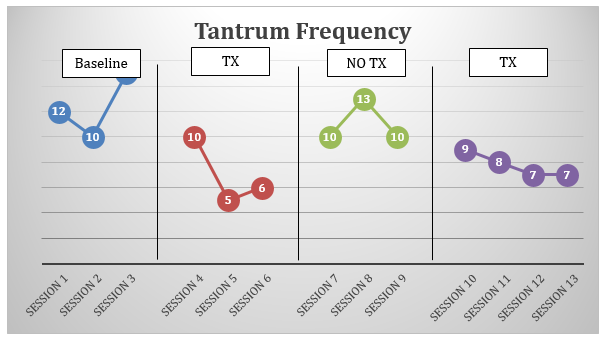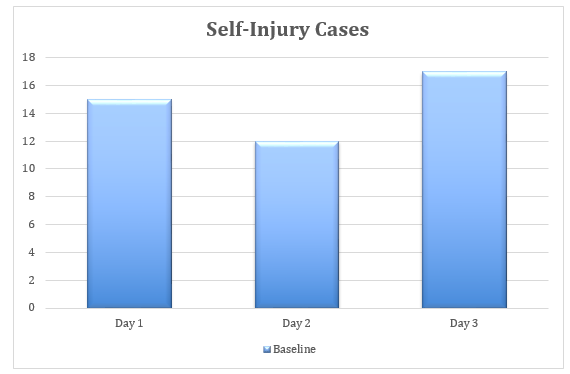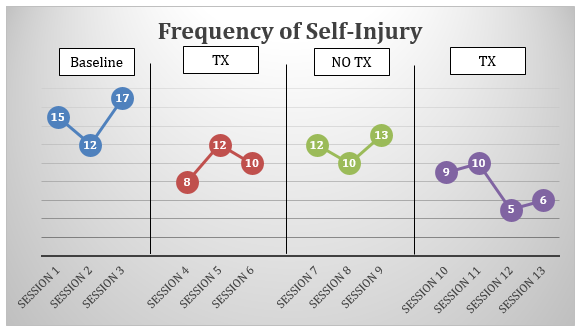L. is a 10-years-old male student, who was diagnosed with autism spectrum disorder (ASD) that is largely expressed in frequent tantrums and the inability to interact within groups, such as a family or peers. Among the interfering behavior of this patient, there is an uncontrollable tantrum that appears when L. is not given attention or an item. Self-harming actions is another destructive behavior that is observed both at school and home. In terms of the Functional Behavior Assessment (FBA), the student is to be observed, and his parents and educators are to be interviewed to suggest potential interventions for addressing the identified behaviors.
Interviews
The parents of L. were interviewed at their home and asked questions about the first signs of autism, its progression, and current challenges. The mother of the student shared that when he was a baby, they went out to have dinner at a restaurant on her first Mother’s Day. As soon as they entered the restaurant, their son began to cry loudly, and nothing could comfort him. The parents attributed this to the fact that he was tired. Furthermore, L. reacted in exactly the same way to every family gathering, birthday party, and any situation, in which there were more than 2-3 people. Currently, large groups of people cause tantrums in the patient. The family spent last Christmas in their house, having dinner and opening the child’s gifts separately from everyone else in the bedroom.
The father of L. noted that his son started using self-injury as a way to make someone turn off the light or sound or as a means to attract the attention of parents. For example, he clarified that L. tried to bite or scratch himself in uncomfortable situations, including the inability to communicate and obtain a desired item. The father explained that often tantrums destroy their life, and that the family needs the strategies to reduce them to handle their daily routine.
The interview with L.’s teacher revealed that she is concerned about tantrums that violate the lessons and distract other children from learning. Considering that the student studies in an inclusive classroom environment, the teacher cannot spend significant time to calm down this student as she also needs to educate others. However, relatively high communicative skills of L. seem to allow him to receive education in the inclusive class. The attitudes of his classmates tend to be varied: while some of them seem to be friendly and ready to help, others are likely to ignore him. The teacher suggested that the applied behavior therapy, the basis of which is the analysis of the child’s behavior and understanding why he behaves this way and not otherwise, can change his current condition.
Operational Definitions of Behaviors
Uncontrolled tantrums refer to an emotional outburst that can be characterized by screaming, crying, angriness, violence, and resistance to pacification attempts that are taken by others. In autism, tantrum occurs when the needs of a child were not met, including a desired item, information, or sameness (Cooper, Heron, & Heward, 2014). In addition, the failure of a person to meet the expectations of children with autism can also result in emotional distress.
Self-injury is the intentional damage made by a person to his or her body, using some objects or one’s hands to do it. Among the most common expressions, there is hair pulling, scratching, arm biting, head or face sapping, and banging on walls and other surfaces. Such factors as bullying, feeling unwell, failing to be listened to, or having no choice can cause self-harm in people with autism.
Direct Observation
Since the interviews demonstrated that tantrums and self-injury were the most common forms of interfering behaviors, two observations were organized. The first observation was conducted in the school environment. Within three days, L. was observed during the lessons, and each of the days was divided into nine periods in accordance with his schedule, which allowed collecting ABC data for each of the intervals.
The observations results pointed to the fact that tantrums appeared at school, while self-injury cases were insignificant and passing rapidly. When one of the students interrupted L., or the teacher paid less attention to him, it caused crying and screaming. Another situation was associated with lying on the floor and crying when the student failed to cope with the assigned tasks. Instead of asking for help, he used the adopted methods for attracting attention to his problems.
The second observation was provided in the student’s home settings in the presence of his parents, but some other family members were also engaged during some days. Namely, the first and third days of observation included the patient, his parents, grandmother, as well as two cousins. It was found that these days were less comfortable for L., who tended to refer to self-injury more often compared to the day two.
It seemed that L. used head slapping and scratching his hands to tell his parents that he feels frustrated and overwhelmed. It is also possible to suggest that his dysfunctional behavior was related to an attempt to cope with the situation and try to relax. When L. suddenly hit his head hard to the wall, his mother responded with active compassion to his physical pain. Accordingly, one may note that head slapping can be a learned behavior that requires the elimination of this discriminative stimulus (Sd).
Hypothesis
Taking into account that there are two interfering behaviors that need to be improved, it is rational to formulate two hypotheses.
- Hypothesis 1: When L.’s expectations regarding his ability to cope with a task or the teacher’s attention are not met, he would have a tantrum in a classroom.
- Hypothesis 2: When the family members other than parents are in his home, L. feels uncomfortable and fails to interact with parents in the usual way, which causes self-injury.
Interventions
The collected data shows that self-injury behavior resulted from the Sd that was learned previously in the course of interacting with the mother. More precisely, it seems that initially, physical pain in head was the reason for slapping it, but L. adopted this behavior to end the unwanted situations. For example, turning the light off or avoiding the group of people at his home. Chart 1 that is presented below illustrates the frequency of self-injury behavior.


Chart 2 demonstrates data that was collected within three days of observing L. in his home settings. The results display the correlation between the presence of more family members and the student’s self-injury cases, especially hand slapping. It is suggested that this interfering behavior requires applying motivating operators to adjust the responses of L. to the identified challenging situations. In addition, it seems to be important to point out the meaning of the data collected and further interventions.
First of all, this analysis gives an understanding that a child with autism needs to be taught literally everything. While ordinary children simply copy their parents and learn, a child with autism cannot do this, so he or she needs to be taught. Speaking more precisely, L. needs to be taught to understand that if he is thirsty, he should not fall to the floor and scream. Instead, it is much more effective to point with his finger, say “give,” or show a card with the corresponding image. It should be stressed that the ABA interventions make it clear that all the processes of learning and communication should be split up into small stages, and each small stage should be trained separately.
The second important aspect is related to the creation of a full-fledged friendly environment for the child, taking into account the difficulties with his perception of life. The more people around this child know what autism is, the more they understand and realize how a person with autism sees the world. The more they take this into account in their reactions and in organizing a learning environment, the more this child tends to adjust to the new behaviors. In other words, the organization of training and the right environment for development are the two most important approaches in the treatment of children with ASD.
Considering that uncontrolled tantrums occurred as a response to the failure to handle a task or have the teacher’s attention, the intervention can be based on positive reinforcement of L.’s reactions. The target behavior can be defined as using a raised hand or a brief question to attract the teacher’s attention, which would reduce tantrums. To assist the student with learning the new behavior, he is to be given an antecedent intervention of high-probability sequence based on prompting. The compliance with the expected behavior should be closely associated with the desired item or activity. The token economy system seems to be a useful instrument to develop such behaviors.
The child does not need to interrupt the lesson every time in order to receive direct encouragement (for example, to eat candy); instead, the token becomes the direct encouragement, and pauses for rewards become less frequent. The token system allows granting the child with rewards that are important to him, but take up too much time. For example, a child can receive tokens as an immediate reward and exchange them later for larger desired activities, such as playing a computer game.
The second intervention is aimed at working with self-injury cases, which is to be achieved though priming as a preliminary training in the necessary skills that the child will need in the near future in communicating with others. The goal of this strategy is to prepare the child for a difficult situation that may arise in inclusion. When a child experiences difficulties during a family meeting, the parents told a fairy tale and played the plot to simulate the situation.
This fairy tale can be read daily to the child during individual interaction, so that he can take an active part in the story game and interact with the whole family. Priming allowed combining individual learning with a common group activity, which is a familiar format for obtaining knowledge and communicating with other people. Using this strategy, it was possible to reduce the behavioral problems that arise during the communication process (Chart 3).

Conclusion
To conclude, one should state that self-injury and uncontrolled tantrums were the key interfering behaviors in L., which were addressed via antecedent priming and prompting, respectively. The two observations and interviews that were conducted at school and home settings clarified the background and the current needs of this student. The data obtained shows that the applied interventions allowed decreasing the frequency of the dysfunctional behavior, which means that L. learned new target behaviors. The findings of this project point to the need to extend the timeframe to collect more information and include additional factors, making more credible conclusions.
References
Cooper, J. O., Heron, T. E., & Heward, W. L. (2014). Applied behavior analysis (2nd ed.). United Kingdom, London: Pearson.